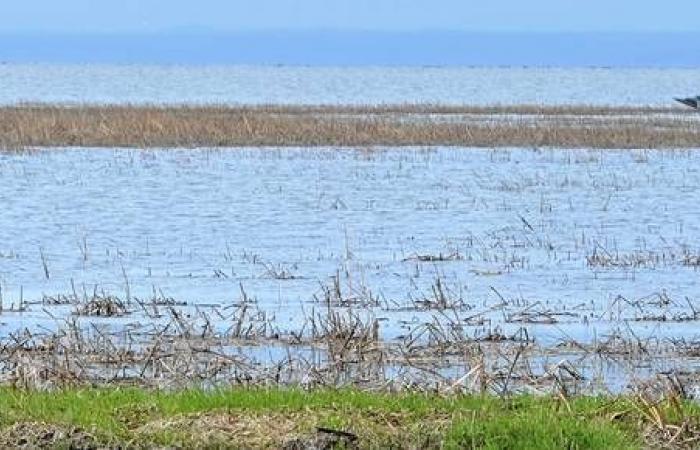Stéphane Campeau, researcher in the “environment and wildlife” axis of the multidisciplinary center of expertise in sustainable management of the Lake Saint-Pierre coastline and professor in the environmental sciences department at UQTR. (Stéphane Lessard/Le Nouvelliste)
“Lake Saint-Pierre really plays a role of kidney, of water purification. It is under very strong pressure because it receives a lot of pollution. All these functions are really specific to Lake Saint-Pierre. This is what makes it what I call the Amazon of Quebec,” underlines Stéphane Campeau, researcher in the “environment and wildlife” axis of the multidisciplinary center of expertise in sustainable management of the Lac Saint coastline. -Pierre and professor in the environmental sciences department at UQTR.
A name that is not exaggerated, he assures.
“When we walk around Lake Saint-Pierre, we have this feeling of a bit of a bayou. And that makes it a very, very diverse environment. We put a lot of attention on deforestation in the Amazon, on what needs to be done to protect this hotspot of biodiversity. But in Quebec, the place where it happens in the St. Lawrence Valley is at Lake Saint-Pierre. It’s a truly exceptional environment, quite unique.”
— Stéphane Campeau, professor in the environmental sciences department at UQTR
Mr. Campeau is one of more than a hundred researchers, students and professionals from three Quebec universities (UQTR, Laval and McGill) who participated in research carried out as part of the multidisciplinary center of expertise in sustainable management of coastline of Lake Saint-Pierre.
After six years of work, these researchers presented, Wednesday morning, their findings and recommendations “with a view to establishing agriculture that respects the ecosystem of Lake Saint-Pierre and restoring priority coastal environments.” .
Source: Summary of research by the Multidisciplinary Center of Expertise in Sustainable Management of the Lake Saint-Pierre Coastline, summary.
“It is essential to extend conservation efforts in order to better protect existing natural environments against any new pressure, to rehabilitate degraded environments and to increase the connectivity of these environments with the river,” underlines Mr. Campeau.
An exceptional environment
It should be remembered that Lake Saint-Pierre is the largest freshwater floodplain in Quebec. Part of the biosphere reserves designated by UNESCO, its coastline, i.e. the area flooded on average every two years, is home to nearly 300 species of resident and migratory birds, 79 species of fish and 40 species of mammals, details the presentation.
Biodiversity under attack
Lake Saint-Pierre represents an exceptional breeding, feeding and nesting environment for several species. (Stéphane Lessard/Archives, Le Nouvelliste)
Nearly 3,800 hectares of wildlife habitats have been modified at Lake Saint-Pierre since 1950, mainly for the benefit of agriculture, indicates the Pole.
“Long used for agriculture, lands in the coastal zone have gradually been converted for corn and soybean production in recent decades. This change in land use has contributed to the decline of biodiversity generally. The situation has become so critical for yellow perch that a moratorium on its fishing has been in place since 2012,” we can read in the Research Summary of the Pole.
“The challenge is to find a balance, a better coexistence between agricultural activities and the ecosystem functions of Lake Saint-Pierre,” says Mr. Campeau.
For example, forms of cultivation allowing the maintenance of permanent vegetation of sufficient height and density in the fall should be favored in low coastal areas, according to the Pole.
Even in higher areas of the coast which are less often flooded, adaptations are necessary. They also constitute a habitat for fish.
“The agro-environmental practices to be favored would include working the soil in the spring after the flood rather than in the fall, the establishment of intercropping cover crops in corn and soybeans, as well as the establishment of strips of perennial vegetation along the banks of watercourses and ditches running alongside cultivated fields,” mentions Caroline Halde, researcher in the “agriculture” axis of the Pole and professor at the Faculty of Agricultural and Food Sciences at Laval University .
According to the latter, “these measures would promote the creation of a variety of habitats favorable to biodiversity”.
The coastline of Lake Saint-Pierre is home to nearly 300 species of resident and migratory birds including the famous snow geese, 79 species of fish and 40 species of mammals. (Sylvain Mayer/Archives, Le Nouvelliste)
Restore the coastline
The Pole’s final report proposes several measures to promote the recovery of the coastline. For example, natural environments, old meadows and strips are conducive to such rehabilitation unlike bare soils or with little crop residue.
He therefore recommends “a permanent vegetation cover offering better spawning habitat for fish in spring” in low-lying areas of the coast, which are more frequently flooded.
As for water quality which is affected by the erosion of agricultural soils and gullying, “respect for riparian strips, revegetation as well as the conservation of natural environments and wooded corridors” are part of the solutions. possible, suggests the Pole.
Researchers from the multidisciplinary center of expertise in sustainable management of the Lake Saint-Pierre coastline presented their findings and recommendations on Wednesday morning. With Professor Stéphane Campeau, we see here Caroline Halde, researcher in the “agriculture” axis of the Pole and professor at the Faculty of Agricultural and Food Sciences at Laval University. (Stéphane Lessard/Le Nouvelliste)
A progressive management approach
Gradual changes are favored “including several modest and concrete objectives likely to maintain the commitment of stakeholders and ensure a transition between today and tomorrow”.
Flexible solutions adapted to their ecological conditions and their socio-economic realities should be offered to agricultural producers, according to the Pole, such as the repurchase of their land on a voluntary basis, financial assistance, peer groups on agricultural practices, expert agricultural advice in the integration of sustainable agricultural practices, etc.
The Center also underlines the importance of supporting farmers. “We have noted that agricultural producers receive little support, in terms of financial assistance and agricultural advice, in the first steps leading them towards the adoption of improved and sustainable practices in the coast of Lake Saint-Pierre,” reports Julie Ruiz, researcher in the “socio-economics” axis of the Center and professor in the Department of Environmental Sciences at UQTR.
Moreover, according to the latter, “the better the practices of agricultural producers from an environmental point of view, the greater their economic losses and their socio-technical challenges”.
There are numerous rehabilitation efforts being carried out around Lake Saint-Pierre, but currently, they result in “small projects which are numerous and quite modest and which struggle to fit into a more global long-term vision. “, explains Ms. Ruiz. “So, in fact, we have difficulty seeing where we are going.”
It is necessary to establish better collaboration between the actors involved, according to the Pole, and improve territorial governance “to facilitate communications and coordination”.
“The absence of a global, long-term vision prevents the creation of a dynamic of collective commitment towards the preservation of the Lake Saint-Pierre ecosystem.”
The Pole relies on a “unifying, solid, legitimate organization with the necessary resources”. “The latter would notably include an interministerial committee, a regional consultation table, a network of local committees and an independent scientific committee.”
The government will hold a consultation in the fall of 2024 with stakeholders in the sector, notably agricultural producers, the fishing sector and conservation organizations.
The summary of the Pole’s research is available online. The final report will be available from July 10.






